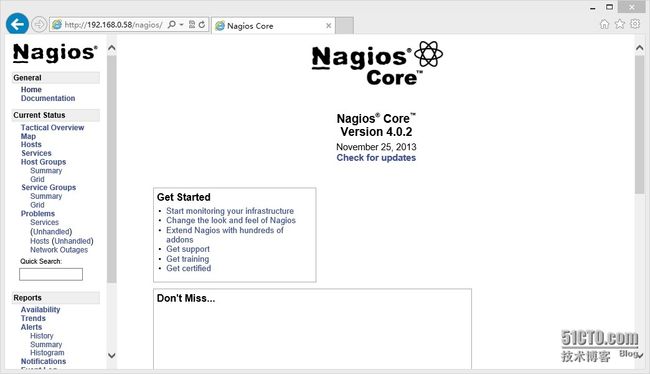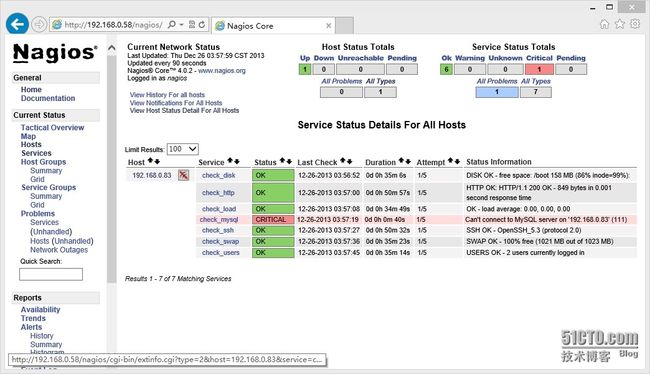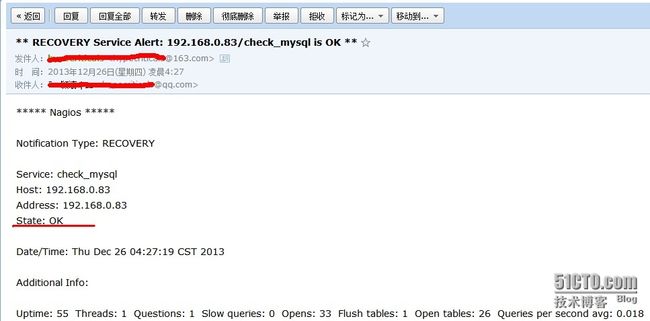环境:
Nagios Server Nagios 6.5
IP:192.168.0.58
Nagios Clint Nagios 6.5
IP:192.168.0.83
另注意:
Nagios需要PHP支持,安装Apache+PHP步骤略....
------------------------------------------------------
——安装Nagios
1)下载Nagios
[root@Nagios ~]# cd /Linux [root@Nagios Linux]# http://jaist.dl.sourceforge.net/project/nagios/nagios-4.x/nagios-4.0.2/nagios-4.0.2.tar.gz
2)编译安装
[root@Nagios Linux]# tar fzvx nagios-4.0.2.tar.gz [root@Nagios Linux]# cd nagios-4.0.2 [root@Nagios nagios-4.0.2]# useradd -M -s /sbin/nologin nagios [root@Nagios nagios-4.0.2]# mkdir /usr/local/nagios [root@Nagios nagios-4.0.2]# chown -R nagios:nagios /usr/local/nagios/ [root@Nagios nagios-4.0.2]# ./configure --prefix=/usr/local/nagios/ [root@Nagios nagios-4.0.2]# make all [root@Nagios nagios-4.0.2]# make install [root@Nagios nagios-4.0.2]# make install-init [root@Nagios nagios-4.0.2]# make install-commandmode [root@Nagios nagios-4.0.2]# make install-config [root@Nagios nagios-4.0.2]# chkconfig --add nagios [root@Nagios nagios-4.0.2]# chkconfig --level 35 nagios on [root@Nagios nagios-4.0.2]# chkconfig --list nagios nagios 0:关闭 1:关闭 2:关闭 3:启用 4:关闭 5:启用 6:关闭 [root@Nagios nagios-4.0.2]# service nagios restart
3)服务端安装Nagios插件plugins
[root@Nagios Linux]# tar zfvx nagios-plugins-1.5.tar.gz [root@Nagios Linux]# cd nagios-plugins-1.5 [root@Nagios nagios-plugins-1.5]# ./configure --prefix=/usr/local/nagios/ [root@Nagios nagios-plugins-1.5]# make && make install
----------------------------------------------------------------------------
4)服务端安装nrpe
[root@Nagios Linux]# tar zfvx nrpe-2.15.tar.gz [root@Nagios Linux]# cd nrpe-2.15 [root@Nagios nrpe-2.15]# ./configure [root@Nagios nrpe-2.15]# make all [root@Nagios nrpe-2.15]# make install-plugin
——Apache配置修改
1)使apache支持nagios
[root@Nagios nagios-plugins-1.5]# vi /usr/local/apache-2.4/conf/httpd.conf ScriptAlias /nagios/cgi-bin "/usr/local/nagios/sbin"AuthType Basic Options ExecCGI AllowOverride None Order allow,deny Allow from all AuthName "Nagios Access" AuthUserFile /usr/local/nagios/etc/htpasswd Require valid-user Alias /nagios "/usr/local/nagios/share"AuthType Basic Options None AllowOverride None Order allow,deny Allow from all AuthName "nagios Access" AuthUserFile /usr/local/nagios/etc/htpasswd Require valid-user
2)添加nagios登陆用户
[root@Nagios nagios-plugins-1.5]# /usr/local/apache-2.4/bin/htpasswd -c /usr/local/nagios/etc/htpasswd nagios New password: Re-type new password: Adding password for user nagios
3)修改apache的用户和用户组
[root@Nagios nagios-plugins-1.5]# vi /usr/local/apache-2.4/conf/httpd.conf User nagios Group nagios
--------------------------------------------------------------------------
4)解决Nagios乱码问题
[root@Nagios nagios-plugins-1.5]# vi /usr/local/apache-2.4/conf/httpd.conf LoadModule cgid_module modules/mod_cgid.so LoadModule actions_module modules/mod_actions.so [root@Nagios nagios-plugins-1.5]# service httpd restart
5)测试访问
——客户端配置
1)客户端安装nagios-plugins
[root@CentOS ~]# cd /Linux [root@CentOS Linux]# useradd -M -s /sbin/nologin nagios [root@CentOS Linux]# tar zfvx nagios-plugins-1.5.tar.gz [root@CentOS Linux]# cd nagios-plugins-1.5 [root@CentOS nagios-plugins-1.5]# ./configure --prefix=/usr/local/nagios/ [root@CentOS nagios-plugins-1.5]# make && make install
2)客户端安装nrpe
[root@CentOS nagios-plugins-1.5]# cd .. [root@CentOS Linux]# tar zfvx nrpe-2.15.tar.gz [root@CentOS Linux]# cd nrpe-2.15 [root@CentOS nrpe-2.15]# ./configure [root@CentOS nrpe-2.15]# make all [root@CentOS nrpe-2.15]# make install-plugin [root@CentOS nrpe-2.15]# make install-daemon [root@CentOS nrpe-2.15]# make install-daemon-config [root@CentOS nrpe-2.15]# vi /usr/local/nagios/etc/nrpe.cfg allowed_hosts=127.0.0.1,192.168.0.58
3)启动nrpe
[root@CentOS nrpe-2.15]# /usr/local/nagios/bin/nrpe -c /usr/local/nagios/etc/nrpe.cfg -d [root@CentOS nrpe-2.15]# echo "/usr/local/nagios/bin/nrpe -c /usr/local/nagios/etc/nrpe.cfg -d" /etc/rc.local
4)检查是否启动
[root@CentOS nrpe-2.15]# netstat -antup |grep 5666 tcp 0 0 0.0.0.0:5666 0.0.0.0:* LISTEN 48456/nrpe tcp 0 0 :::5666 :::* LISTEN 48456/nrpe
5)在服务端检查 [如果返回NRPE版本及成功,相反则检查配置]
[root@Nagios ~]# /usr/local/nagios/libexec/check_nrpe -H 192.168.0.83 NRPE v2.15
=========================================================================================
——配置nagios
[root@Nagios nrpe-2.15]# cd /usr/local/nagios/etc/
1)编辑nagios.cfg
[root@Nagios etc]# vi nagios.cfg 注释下面的内容 #cfg_file=/usr/local/nagios/etc/objects/commands.cfg #cfg_file=/usr/local/nagios/etc/objects/contacts.cfg #cfg_file=/usr/local/nagios/etc/objects/timeperiods.cfg #cfg_file=/usr/local/nagios/etc/objects/templates.cfg #cfg_file=/usr/local/nagios/etc/objects/localhost.cfg #cfg_file=/usr/local/nagios/etc/objects/windows.cfg #cfg_file=/usr/local/nagios/etc/objects/switch.cfg #添加监控主机目录 cfg_dir=/usr/local/nagios/etc/objects/hosts #添加模板目录 cfg_dir=/usr/local/nagios/etc/objects/templates
2)创建相关目录
[root@Nagios etc]# mdkir objects/templates [root@Nagios etc]# mdkir objects/hosts
3)复制所需文件
[root@Nagios etc]# cp objects/commands.cfg objects/templates/ [root@Nagios etc]# cp objects/timeperiods.cfg objects/templates/
4)创建自定义模板
[root@Nagios etc]# vi objects/templates/templates.cfg
#联系人模板
define contact{
#联系人名称
name tao
#当服务出现异常时 发送通知的时间段
service_notification_period 24x7
#当主机出现异常时 发送通知的时间段
host_notification_period 24x7
#w 表示警告 u 表示不明 c 表示紧急 r 表示恢复
service_notification_options w,u,c,r
#d 表示宕机 u 表示不可达 r 表示重新恢复
host_notification_options d,u,r
#服务故障时 发送通知的方式[邮件]
service_notification_commands notify-service-by-email
#主机故障时 发送通知的方式[邮件]
host_notification_commands notify-host-by-email
register 0
}
#主机模板
define host{
#定义主机名
name linux-host
#其值为1 Nagios将收集的数据写入某个文件中 以备提取
process_perf_data 1
passive_checks_enabled 0
#主机与服务的刷新检测 0为关闭
check_freshness 0
#事件处理开启
event_handler_enabled 1
#打开抖动感知
flap_detection_enabled 1
active_checks_enabled 1
#发送通知的时间段
notification_period 24x7
#检查主机的时间段
check_period 24x7
#对主机的检查时间间隔/分钟
check_interval 5
#如果宕机重试检查时间/分钟
retry_interval 1
#宕机后对主机的最大检查次数
max_check_attempts 2
#检查主机状态指令[在commands.cfg中定义]
check_command check-host-alive
#在主机出现异常后 故障一直没有解决 再次发送通知的时间/分钟
notification_interval 5
#d 表示宕机 u 表示不可达 r 表示重新恢复
notification_options d,u,r
#1为开启报警信息
notifications_enabled 0
#指定联系人组[在contacts.cfg中定义]
contact_groups admins
#处理性能数据
#一天刷新检测一次,以防止检测结果不是实时的
freshness_threshold 86400
#0为不注册,意思是这个作为模板
register 0
}
#服务模板
define service{
#定义一个服务名称
name linux-service
#启用主动服务检查
active_checks_enabled 1
#启用被动服务检查
passive_checks_enabled 0
#主机与服务的刷新检测
check_freshness 0
#开启报警信息
notifications_enabled 1
#重新发送报警信息的间隔
notification_interval 5
#事件处理开启
event_handler_enabled 1
#启用抖动感知
flap_detection_enabled 1
#处理性能数据
process_perf_data 1
#发送通知的时间段
notification_period 24x7
#检查时间段
check_period 24x7
#如果宕机最大检查次数
max_check_attempts 5
#检查服务时间间隔/分钟
normal_check_interval 1
#如果宕机再次检查的间隔时间/分钟
retry_check_interval 1
#一天刷新检测一次,以防止检测结果不是实时的
freshness_threshold 86400
#0为不注册,意思是这个作为模板
register 0
}
define service {
name test
#1为开启报警信息
notifications_enabled 0
#重新发送报警信息的间隔
notification_interval 5
notification_options w,u,c,
#事件处理开启
event_handler_enabled 1
#打开抖动感知
flap_detection_enabled 1
#发送通知的时间段
notification_period 24x7
#检查时间段
check_period 24x7
#每一次检测的间隔时间
check_interval 1
#如果宕机再次检查的间隔时间
retry_interval 1
#检测次数,如果2次都是宕机的话 就报警
max_check_attempts 2
active_checks_enabled 1
passive_checks_enabled 0
#处理性能数据
process_perf_data 1
#主机与服务的刷新检测 0为关闭
check_freshness 0
#一天刷新检测一次,以防止检测结果不是实时的
freshness_threshold 86400
#0为不注册,意思是这个作为模板
register 0
}
[root@Nagios etc]# vi objects/templates/contacts.cfg
#联系人
define contact{
#用户名称
contact_name nagios
#引用模板
use tao
#别名
alias Nagios Admin
#发送邮箱
email [email protected]
}
#联系人组
define contactgroup{
#组名称
contactgroup_name admins
#组别名
alias Nagios Administrators
#组用户成员
members nagios
}
5)添加监控主机
最好使用被监控机IP为名称、比如:被监控服务器为192.168.0.83 [后期服务器多的时候、容易维护]
这里为了省事、一台服务器监控多种服务。大家测试的时候、可以添加多个服务器监控不同服务。
[root@Nagios etc]# vi objects/hosts/192.168.0.83.cfg
#监控主机
define host {
host_name 192.168.0.83
address 192.168.0.83
use linux-host
}
#监控SSH
define service {
service_description check_ssh
check_command check_ssh!-p 22
host_name 192.168.0.83
use linux-service
register 1
}
#监控登陆用户
define service {
service_description check_users
check_command check_nrpe!check_users
host_name 192.168.0.83
use linux-service
register 1
}
#监控mysql [需要在被监控配置、下面有配置说明]
define service {
service_description check_mysql
check_command check_mysql
host_name 192.168.0.83
use linux-service
register 1
}
#监控交换空间
define service {
service_description check_swap
check_command check_nrpe!check_swap
host_name 192.168.0.83
use linux-service
register 1
}
#监控磁盘
define service {
service_description check_disk
check_command check_nrpe!check_disk
host_name 192.168.0.83
use linux-service
register 1
}
#监控HTTP
define service {
service_description check_http
check_command check_http!-p 80
host_name 192.168.0.83
use linux-service
register 1
}
#监控负载
define service {
service_description check_load
check_command check_nrpe!check_load
host_name 192.168.0.83
use linux-service
register
}
6)重启启动nagios、登陆WEB查看
网上很多人说配置后,执行命令检查是否有错误。个人感觉完全没必要、因为启动的时候Nagios默认会自动检查配置、如果有错误Nagios会提示。
[root@Nagios etc]# service nagios restart
——测试
1)在客户端 登陆nagios
注意:监控MySQL需要在被监控端配置如下:
1)客户端连接mysql添加nagios用户
mysql> create database nagios; Query OK, 1 row affected (0.00 sec) mysql> grant select on nagios.* to nagios@'192.168.1.18' identified by 'nagios'; Query OK, 0 rows affected (0.11 sec) mysql> flush privileges; Query OK, 0 rows affected (0.00 sec) mysql> quit
2)Nagios服务器端添加mysql监控
[root@Nagios nrpe-2.15]# vi /usr/local/nagios/etc/objects/templates/commands.cfg
# 'check_mysql' command definition
define command{
command_name check_mysql
command_line $USER1$/check_nrpe -H $HOSTADDRESS$ -u nagios -d nagios -p nagios
}
——安装msmtp
1)下载安装msmtp
[root@Nagios Linux]# wget http://jaist.dl.sourceforge.net/project/msmtp/msmtp/1.4.31/msmtp-1.4.31.tar.bz2 [root@Nagios Linux]# tar fvx msmtp-1.4.31.tar.bz2 [root@Nagios Linux]# cd msmtp-1.4.31 [root@Nagios msmtp-1.4.31]# ./configure --prefix=/usr/local/msmtp [root@Nagios msmtp-1.4.31]# make && make install [root@Nagios msmtp-1.4.31]# cd /usr/local/msmtp/
2)配置msmtp
[root@Nagios msmtp]# mkdir etc [root@Nagios msmtp]# cd etc/ [root@Nagios etc]# vi msmtprc account default logfile /usr/local/msmtp/msmtp.log host smtp.163.com from [email protected] auth login user [email protected] #邮箱密码 password xxxxxx
3)安装mutt
[root@Nagios etc]# yum install mutt -y
4)配置mutt
[root@Nagios etc]# vi /etc/Muttrc set sendmail="/usr/local/msmtp/bin/msmtp" set use_from=yes set realname="YingTao" set [email protected] set envelope_from=yes set editor="vim" set record="/usr/local/msmtp/etc/sent"
5)Nagios默认使用sendmail发送邮件、只需要把 /bin/mail 改为 /usr/bin/mutt即可。
[root@Nagios etc]# vi objects/templates/commands.cfg
# 'notify-host-by-email' command definition
define command{
command_name notify-host-by-email
command_line /usr/bin/printf "%b" "***** Nagios *****\n\nNotification Type: $NOTIFICATIONTYPE$\nHost: $HOSTNAME$\nState: $HOSTSTATE$\nAddress: $HOSTADDRESS$\nInfo: $HOSTOUTPUT$\n\nDate/Time: $LONGDATETIME$\n" | /usr/bin/mutt -s "** $NOTIFICATIONTYPE$ Host Alert: $HOSTNAME$ is $HOSTSTATE$ **" $CONTACTEMAIL$
}
# 'notify-service-by-email' command definition
define command{
command_name notify-service-by-email
command_line /usr/bin/printf "%b" "***** Nagios *****\n\nNotification Type: $NOTIFICATIONTYPE$\n\nService: $SERVICEDESC$\nHost: $HOSTALIAS$\nAddress: $HOSTADDRESS$\nState: $SERVICESTATE$\n\nDate/Time: $LONGDATETIME$\n\nAdditional Info:\n\n$SERVICEOUTPUT$\n" | /usr/bin/mutt -s "** $NOTIFICATIONTYPE$ Service Alert: $HOSTALIAS$/$SERVICEDESC$ is $SERVICESTATE$ **" $CONTACTEMAIL$
}
——测试能否通过邮箱报警
1)在被监控端关闭mysql
[root@CentOS ~]# /etc/init.d/mysqld stop Shutting down MySQL. SUCCESS! [root@CentOS ~]# netstat -antup |grep 3306
2)登陆WEB Nagios查看MySQL状态
3)在服务端查看日志 [默认日志路径为/usr/local/nagios/var/]
[root@Nagios ~]# cd /usr/local/nagios/var/ [root@Nagios var]# tail -f nagios.log #检查五次、如果五次服务还是无法检测到服务是正常的,则发邮件通知。 [1388002399] SERVICE ALERT: 192.168.0.83;check_mysql;CRITICAL;SOFT;1;Can't connect to MySQL server on '192.168.0.83' (111) [1388002459] SERVICE ALERT: 192.168.0.83;check_mysql;CRITICAL;SOFT;2;Can't connect to MySQL server on '192.168.0.83' (111) [1388002519] SERVICE ALERT: 192.168.0.83;check_mysql;CRITICAL;SOFT;3;Can't connect to MySQL server on '192.168.0.83' (111) [1388002579] SERVICE ALERT: 192.168.0.83;check_mysql;CRITICAL;SOFT;4;Can't connect to MySQL server on '192.168.0.83' (111) [1388002639] SERVICE ALERT: 192.168.0.83;check_mysql;CRITICAL;HARD;5;Can't connect to MySQL server on '192.168.0.83' (111) [1388002639] SERVICE NOTIFICATION: nagios;192.168.0.83;check_mysql;CRITICAL;notify-service-by-email;Can't connect to MySQL server on '192.168.0.83' (111)
4)登陆邮箱查看是否收到邮件 [由于是虚拟机时间没有调整、和现实时间有差别]
5)重新启动MySQL
[root@CentOS ~]# /etc/init.d/mysqld start Starting MySQL.. SUCCESS! [root@CentOS ~]# netstat -antup |grep 3306 tcp 0 0 0.0.0.0:3306 0.0.0.0:* LISTEN 51040/mysqld
6)检测服务恢复正常后,是否收到邮件通知




